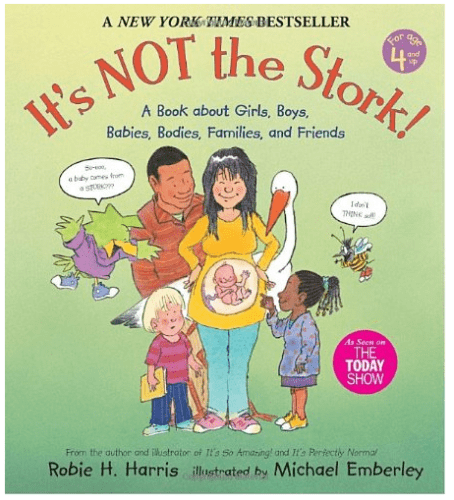The sex talk. It’s one of the most dreaded tasks in parenting, right? Sometimes it even feels hard when they give you an obvious opening like asking, “How did a baby get in your belly?” while you are pregnant with their younger brother or sister. We freeze up and don’t know what to say or how much to say.
But, I think that if we brush off those questions and wait, it just gets harder to make that beginning and get the conversation started. For me personally, I have always leaned heavily on books to ease the way. I might not have the right words for each age group, but there are experts who do. And thank goodness, because it takes a lot of the awkwardness away for the parent giving “the talk.”
If you’ve been wanting to talk to your young kids about sex, how babies are made, or about good touches and bad touches, but you feel like you don’t know where to start, this post is for you.
I’ve put together a list of books that are great resources to help you talk to your kids in age-appropriate ways. They’ll help you teach your child to understand his or her body. Ultimately, that helps keep kids safe and helps them make smart choices as they grow up.
When you use these books to get the conversation about sex started with your kids or to answer their questions, read them WITH your young kids rather than giving them to your kids to read on their own. That way, you can encourage them to ask questions as you go, and follow up with extra information along the way or after you read.
The Sex Talk with Toddlers

Title: “Where Do Babies Come From?”
Age: Appropriate for toddlers and preschoolers
Why I recommend it: This book gives a simple explanation for little kids, answering the classic question, “Where do babies come from?”. It simply explains that all animals, including people, come from a sperm and an egg. It doesn’t take it any farther than that. There’s no explanation of how the sperm and the egg get together, just an easy biology lesson suitable even for toddlers.
The Sex Talk with Preschool – Early Elementary Kids

Title: “It’s Not the Stork: A Book About Girls, Boys, Babies, Bodies, Families and Friends”
Age: Appropriate for Pre-K to 3rd grade
Why I recommend it: This book offers a great beginning understanding of exactly what body parts boys and girls have and how they are different and similar, how babies are conceived, how babies grow, how babies are born, and healthy relationships, including OK/not OK touches. Illustrations of a very curious and interested bird and a slightly embarrassed bee give commentary along the way. These illustrations entertain kids. They ask questions your kids might have. And, they mirror how kids might feel as you read them the book.
The Sex Talk with School Age Kids

Title: “It’s So Amazing!”
Age: Appropriate for 2nd – 5th graders
Why I recommend it: “It’s So Amazing” is part of the same series as “It’s Not the Stork.” But this book goes a little bit more in-depth for slightly older children. It covers boys’ and girls’ bodies and the changes they’ll experience during puberty, sex, birth control, chromosomes and genes, adoption, and more.
The Good Touch/Bad Touch Talk with Young Kids

Title: “No Trespassing – This is My Body!”
Age: Appropriate for Pre-K – 3rd graders
Why I recommend it: Our children’s physical and emotional safety is always priority number one for us as parents. This book helps give kids the tools and knowledge to make it their priority, too. Through a story about siblings talking with a parent, kids learn three important concepts. First, they learn that their private parts are private. Second, they learn that they can make decisions about what kind of touches are OK for them and that it’s OK to say no when they are uncomfortable. That includes hugs, kisses, tickles, as well as inappropriate touches.* Lastly, kids learn that families should be a “No Secrets” zone. They never have to be afraid to tell mom and dad about anything. A parent guide at the end has information designed to help you protect your child from abuse.
*Side note: We as parents need to listen when kids say “no” to the touches that seem inoffensive, like a hug or tickle. Otherwise, this message is kind of meaningless.
So next time your child asks you where babies come from, don’t panic. You’ve got this under control with all the resources you need to make the conversation smooth and easy.










